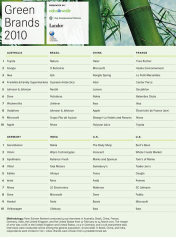 The 5th annual ImagePower Green Brands Study sponsored by Landor Associates, Cohn & Wolfe, Etsy Environmental Partners (EEP), and Penn Schoen Berland (PSB) has been released.
The 5th annual ImagePower Green Brands Study sponsored by Landor Associates, Cohn & Wolfe, Etsy Environmental Partners (EEP), and Penn Schoen Berland (PSB) has been released.
The 2010 study polled more than 9,000 people in eight countries: the United States, the United Kingdom, Australia, Germany, Brazil, China, France, and India.
The results of the survey show that consumers continue to be concerned about the environmental-friendliness of products and brands. In fact, concern increased by 3.5% over 2009 results.
The 2010 ImagePower Green Brands Study reports the following conclusions, which you can read about in more detail on the Landor Associates blog:
- Most consumers want to buy from environmentally-friendly companies.
- The market for green products is growing in emerging economies.
- Environmental concerns vary by country.
- Hurdles to buying green vary by market.
- Consumers learn about green products and companies in different ways.
From a branding perspective, the study reveals that environmental consciousness is very important to consumers, ranking fourth in terms of what consumers are looking for in a brand behind providing a good value, being trustworthy, and caring about consumers.
So who is doing it right? In the United States, Burt’s Bees and Whole Foods Markets lead the pack as far as consumer perceptions related to being a green brand. In the United Kingdom, The Body Shop comes out on top, while Australian consumers rank Toyota number one. You can follow the link to see the complete list of green brands by country.
One of the biggest learnings from the 2010 study and the four annual studies conducted previously is the obvious difference between consumers in different countries related to the importance of green brands and the messages marketers should focus on related to the environment in order to appeal to those geographic differences in consumer perceptions. For example, consumers in the United States and the United Kingdom are more concerned with energy while consumers in Australia are more concerned with water management. In other words, a one-size-fits all green marketing plan won’t work as consumers become better educated around the world about the importance of companies and brands being environmentally conscious.
What brand do you think is doing a good job of being green? Leave a comment and share your thoughts.
Susan Gunelius is the author of 10 marketing, social media, branding, copywriting, and technology books, and she is President & CEO of KeySplash Creative, Inc., a marketing communications company. She also owns Women on Business, an award-wining blog for business women. She is a featured columnist for Entrepreneur.com and Forbes.com, and her marketing-related articles have appeared on websites such as MSNBC.com, BusinessWeek.com, TodayShow.com, and more.
She has over 20 years of experience in the marketing field having spent the first decade of her career directing marketing programs for some of the largest companies in the world, including divisions of AT&T and HSBC. Today, her clients include large and small companies around the world and household brands like Citigroup, Cox Communications, Intuit, and more. Susan is frequently interviewed about marketing and branding by television, radio, print, and online media organizations, and she speaks about these topics at events around the world. You can connect with her on Twitter, Facebook, LinkedIn, or Google+.


